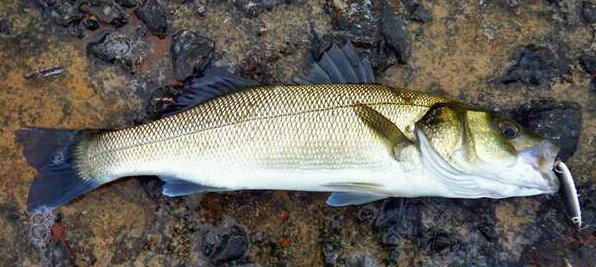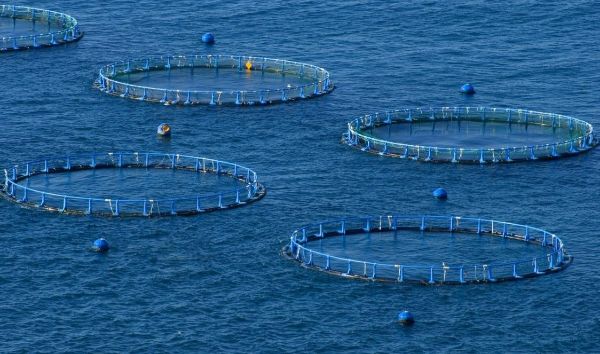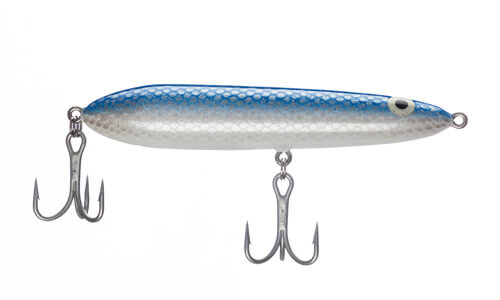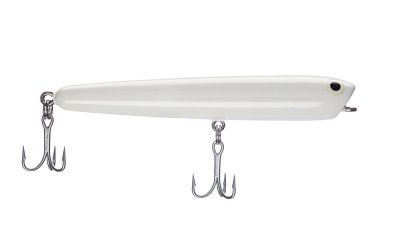Are you looking for a good lure for bass fishing? This grayish fish is one of the most desired catches by fishermen around the world. But, when diving into bass fishing, the lure we choose is a big a key to success. At Chinesteta we have vast experience in the manufacture of fishing lures for sea bass, and in this article we’ll go over the main points to consider in choosing a good lure.
But before going into this, let’s have a brief introduction to sea bass, one of the most sought-after catches.
The characteristics of sea bass
Sea bass is a medium to large size fish commonly found throughout the Mediterranean and the Atlantic Ocean, from the African coasts (Senegal) to Norway. They can weigh up to 10kgs, but an average catch is usually just over a kilo (in fact, catching a 4 or 5 kilogram bass would be considered a big success!).

A Bass caught with a Chinesteta fishing lure
This species has a greyish colour, with the belly being pearly white, has a curved shape which is very noticeable for fishermen. Just like black bass, it stands out for its wide mouth, very strong and inclement with its prey. Both fish have very similar habits.
The sea bass is a very coveted fish by fishermen, who seek it out for several reasons. The first is its attractive shape and colours, which clearly differentiate it from other fish. The second is its aggressiveness; it is a voracious fish which attacks its prey in quite a unique manner. All this makes it a very interesting catch. Finally, it is known for its meat, which is very tasty.
Although complicated to fish, in some places the number of sea bass in the water is quite high, mainly because many of them escape from fish farms. When the sea is rough the cages often break and these fish are free, which results in the presence of thousands of sea bass along our shores from fish farms. These seabass which have originally been bred in captivity, are much easier to fish. This is because during the breeding process in the farms, they are fed very frequently to encourage them to grow faster. Once released, they have to be very aggressive to be able to feed at the same pace. This makes them easier for fishermen to catch.

A fish farm in the sea
If these reasons motivate you, and you want to get into a good adventure, one of the first steps to take is to choose good equipment. And the key element here is a suitable lure. To help you in this process, we’ve put together 5 tips for choosing the best lure for bass.
How to Choose the Best Lure for Sea Bass
Casting it far enough
Let’s be clear: wild sea bass do not make it easy for fisherman. Whether they are in salt water or in fresh water, they often choose hidden places to hide, and of course if we wish to catch them we’ll first have to reach them.
In the case of sea fishing, seabass are usually in areas where the waves break, some distance from the coast. If the sea is calm we’ll be able to fish in a boat, but if it’s rough – as it usually is in the Bay of Biscay, for example – we will need a sea bass lure that can be thrown from the shore, and travel as far as possible.
Chinesteta lures are made of wood, which allows them to be cast for up to 40 metres (130ft) farther than other fishing lures. This makes them perfect for reaching those sea bass that appear to be unreachable.
In this regard, a good choice is the Chinesteta Bluefish 125, a piece with an outstanding cast. The Bluefish 125 flies like a bullet and reaches much further than other sea bass lures.
Find a sea bass lure to withstand the roughest waters
Sea bass is a fish that usually attacks when there are waves and the water is rough. They go to where the waves break, and take advantage of the foam when hunting their prey. As we mentioned in the previous point, it is imperative that our sea bass lure be cast well and be able to reach into those areas. However, if it does reach, but does not withstand the impact of the waves well when submerging in the water, we will lose everything we have achieved thus far. So, we’ll need a resistant, heavy fishing lure that will withstand the movement of the wildest waters.
At Chinesteta we manufacture very resistant lures. The Seabass 120 is especially suitable. It is of medium size, heavy, and withstand the impact of waves very well.
Avoiding fishing lures with rattles
Basses are extraordinarily cautious fish, who have learned to recognise the rattle of lures and who are not likely to fall for this deception. In addition to living in the sea, in ports, docks, marshes and breakwaters, they also tend to go up rivers to fresh water environments. They use reeds, ships, rocks and the most hidden obstacles along the shore, both to hide and to hunt the unsuspecting small fish that are within their reach.
There are no waves in these areas, so they are much calmer and quieter. We’ll therefore need a fishing lure for quiet bass, with no rattles. so as not to scare these fish away with their sound. None of the Chinesteta lures rattle, making them perfect for fishing for this prey. The bass will be much more trusting of a silent lure, which they will not relate to fishermen.
Find a bass lure that allows you to play around with movement
As in fishing for the vast majority of fish, the movement that your lure allows you to make is key when it comes to catching bass.
With this fish, a zig zag (also called “walking the dog”) is used, which is the most common in attracting them. Depending on the model of lure you use, you can perform this zigzag movement in a wider or shorter manner. Let’s see when it is better to choose one or the other.
- If we see that the bass is aggressive, it will be more effective to make short and fast movements. The fish will more easily detect the lure, and will not hesitate to attack it. The Seabass 120 from Chinesteta is perfect for making these kinds of movements.
- If, on the other hand, we detect that the sea bass are suspicious, we must use a lure that allows us to make larger and slower movements. If the fish are cautious, this slower movement won’t frighten them as much and will give them greater confidence. Do you know which lure to use for this? The Sea Fishing 120 is perfect.
The quality of the hook is important
A good hook is always important when fishing! But with the sea bass this is especially the case. Depending on the type of water in which they are found, our lure must have a good triple.
- When fishing in fresh water, we would do well with a basic hook – always of good quality. The sea bass is an aggressive fish, so we want it to be reinforced so as to handle its bites without bending. The Black Bass 120 from Chinesteta is very suitable for this purpose.
- When fishing in salt water, we must bear in mind that the triple should be salt resistant. Otherwise, it will rust upon contact with water. In the sea it is especially important that the triple of our lure sea bass lure be reinforced. At Chinesteta we work with very high quality hooks, which you can find on many of our models: Seabass 120, Sea Fishing 120, Bluefish 125. All of them have reinforced and saltwater coating triples.
All Chinesteta lures are armed with quality triples approved by fishermen from all over the world. Whether you fish with a Chinesteta lure or with any other brand, always pay attention to the hooks! They can make the difference between getting a catch or not.
Other recommendations for bass fishing
Now that we have already seen the main points to keep an eye on when choosing a bass fishing lure, we will go over a series of general recommendations.
- The lure that we choose is vital, but the rod also plays a fundamental role. It will have to be long enough to support the weight of the chosen lure. For a 100-120mm Chinesteta lure, the ideal rod will be 2.10m long. For heavier bass-fishing lures, we’ll need 2.70m rods. It’s important to choose a rod that has the right action for the lure. Otherwise, we could end up breaking the ring or the tip.
- Like many predators, seabass is a species that is most active in low light conditions, so it will be easier to find them at dawn, dusk and night. It is a good strategy to take advantage of those hours of darkness to tempt them, and catch them.Although it is more common to do so at dawn, there are also fishermen who try their luck at night. They usually go to port or breakwater areas, to take advantage of nearby lights and not be in total darkness. However, there are also fishermen who fish in more hidden places, without lighting. In these areas, sea bass are more confident because they are not so used to fishermen. However, it is dangerous for the fishermen, who may have an accident due to lack of light and not then be able to find help in the vicinity.
- With sea bass fishing, catching and letting go is quite common. This is one of the most important habits among fishermen, who often promote it to avoid the depletion of the fish and to continue fishing sustainably.
Conclusion
As we said before, sea bass is not an easy fish to catch. It is difficult and very cautious, hides and is distrustful of noises. Beginners may find it difficult to find them, or not to scare them. But, like everything else, practice makes perfect. Experience will teach the fisherman where to look for these fish, and how to make the right moves to catch them. For this reason, it will always be essential to have a good rod and a decent sea bass lure.





